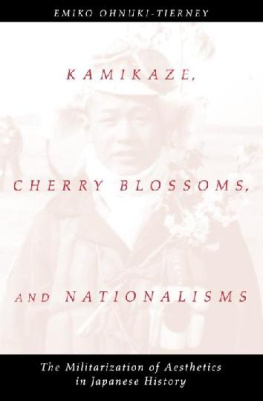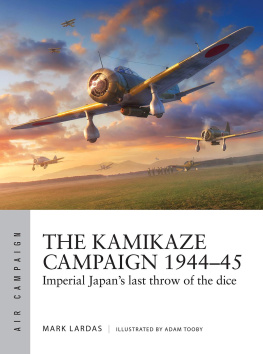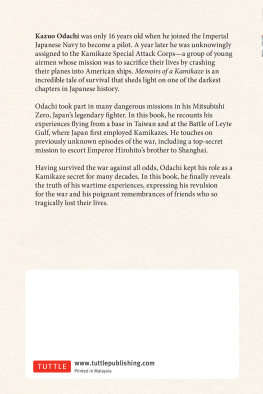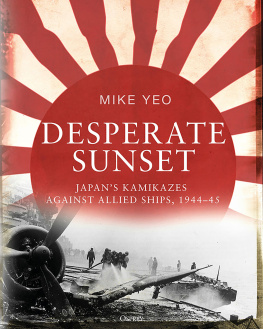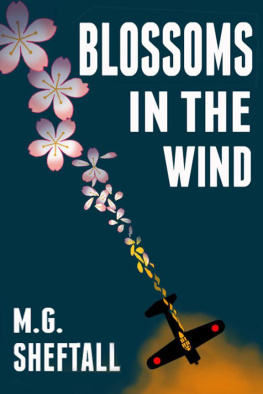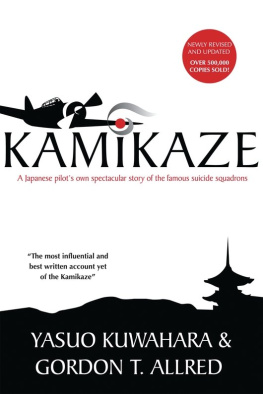Kamikaze Diaries
Kamikaze Diaries
Reflections of Japanese Student Soldiers
Emiko Ohnuki-Tierney
The University of Chicago Press
Chicago and London
Emiko Ohnuki-Tierney is the William F. Vilas Research Professor in the Department of Anthropology at the University of WisconsinMadison. She has written a number of books in English and Japanese, including Kamikaze, Cherry Blossoms, and National isms: The Militarization of Aesthetics in Japanese History (2002), also published by the University of Chicago Press.
The University of Chicago Press, Chicago 60637
The University of Chicago Press, Ltd., London
2006 by The University of Chicago
All rights reserved. Published 2006
Printed in the United States of America
15 14 13 12 11 10 09 08 07 06
1 2 3 4 5
ISBN: 0-226-61950-8 (cloth)
Library of Congress Cataloging-in-Publication Data
Ohnuki-Tierney, Emiko.
Kamikaze diaries : reflections of Japanese student soldiers.
p. cm.
Includes index.
ISBN 0-226-61950-8 (cloth)
1. World War, 19391945Aerial operations, Japanese. 2. Kamikaze pilots
Diaries. 3. Japan. Kaigun. Kamikaze Tokubetsu Kgekitai. I. Title.
D792.J3o265 2006
940.54'49520922dc22
[B]
2005035596
This book is printed on acid-free paper.
May the reflections of these young men
whose lives were cut short
provide us with strength to fight against all wars
Acknowledgments
The idea for this book was originally proposed by the University of Chicago Press, which published my book Kamikaze, Cherry Blossoms, and Nationalisms: The Militarization of Aes thetics in Japanese History. I found the diaries left by highly intelligent young men who perished in a meaningless war so painful to read that without the sustained encouragement of my colleagues I would not have been able to complete the task. I gratefully acknowledge moral support extended by Martin Dworkin, Henry Rosovsky, Peter Spear, Peter Stansky, and Halliman Winsborough. I thank Norma Field for her suggestion for the book title, Kamikaze Diaries. Stephen Vlastos, Keith Hart, and Bruce Cumings offered their advice and comments on my discussion of the kamikaze metaphor and 9/11, now included in the preamble. David Brents prodding rescued me from a most superficial reading of Kants aesthetics. H. Mack Horton translated the poems of Teika through which Matsunaga Tatsuki expressed his innermost thoughts and which now are available in Hortons exquisite translation. My discussions with Kishi Toshimitsu have been invaluable, and he also located invaluable photos of wartime propaganda for me. Grey Osterud was indeed more than an editor extraordinaire, as she is known; her scholarly commentaries and antiwar moral stance quickly created a bond between us. Richard C. Miller offered his expert knowledge of European publications and music, in addition to his collegiality. Critical commentaries on various aspects of this project were offered by Kenji Tierney, who also located important publications and the illustrations that are used in this book. Elizabeth Branch Dyson was most helpful in offering me advice and facilitating the review process in such an efficient and pleasant way.
The lectures I gave on this subject were important opportunities for me to think about this project, and I thank the following host institutions, as well as the comments from the audiences: the American Academy of Arts and Sciences (Midwest Center); the University of Chicago; Durham University; the cole des Hautes tudes en Sciences Sociales, Paris; the University of California, Berkeley and Los Angeles; Harvard University; the University of Hong Kong; the International House of Japan; the University of Iowa; the University of Kansas; the London School of Economics; Middlebury College; Oxford University; the University of Pennsylvania; Seij University; the University of Wisconsin; and Yale University.
Above all, I thank the siblings of these fallen soldiers, who, despite the pain they felt every time their brothers memories were evoked, encouraged me and supplied me with invaluable material, including photos from their family albums: They are Sasaki Taiz, professor of physics at the University of Tokyo, Nakao Yoshitaka, professor at Seinan Gakuin University, and Umezawa Shz. Their discussions with me strengthened my resolve to complete this project. I express my gratitude to Kasuga Takeo, who gave me permission on September 8, 2000, to use his letter describing the night before the pilots took off (quoted in the Introduction).
I am most grateful to the William F. Vilas Trust Fund of the University of WisconsinMadison, whose generous support enabled me to complete this project in a timely fashion.
E. O.-T.
Authors Note
Because each student wrote his diary differently, I chose the best way to introduce a particular student, without imposing a uniform format for all the chapters. Always trying to follow a somewhat chronological order, I also used the themes as an organizational principle. The balance between the two differs from student to student. For example, for Sasaki Hachir (chapter 1), the thematic arrangement received priority, whereas for others, more emphasis was placed on chronological sequence.
When dates were noted, I have included the date of the diary entry with the month, the day, and the year. Not all entries were dated; for undated entries I have noted the numbers of the pages where they appeared. The years are given using the secular English system of dating, with b . c . e . for before the common era and c . e . for during the common era, since the Latin Christian forms, the Japanese forms used after the Meiji Restoration, with the fictional date of the enthronement of the so-called first emperor counted as the first year, and another Japanese system using the years of the emperors reign are all religious-cum-political.
The days of the month are usually given according to Japanese time, which is a day ahead of the United States. For example, World War II ended on August 14 in Japan. The dates given in the diaries and letters are those given in the original writings or publications.
Unless otherwise indicated, all translations from the Japanese are my own. Words in brackets are my editorial insertions. The student soldiers frequently used foreign languages, including the titles of books, articles, and works of music. When I was sure of spelling errors, I simply noted the correct spelling. Given that this book is addressed primarily to English-speaking readers, the titles appear first in standard English translation, when available, followed by the titles in the original language in brackets.
I follow the Japanese convention for names, with the last name followed by the first name without a comma in between.
Preamble
How lonely is the sound of the clock in the darkness of the night is the first line of a poem titled Stillness, composed by Nakao Teketoku, a tokktai (kamikaze) pilot, on September 20, 1942. He perished at the age of twenty-two (see chapter 6). Student soldiers in their late teens to early twenties often grabbed the clock to stop it, since with every tick the hand was advancing toward their death. Inconceivable as it is today, well before they were drafted into the military these young men had been living in the shadow of imminent death because the Japanese state had managed to promote and inculcate in the minds of the people the idea that all the Japanese, but especially the soldiers-to-be, must sacrifice their lives for the country.
We begin with the voices of tokktai pilots and other student soldiers, whose diaries and reflections make up this book.


